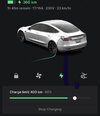Hi all
I use a 6-20 setup at home and wondering why the amps show 17/16a instead of 16/16a
It shows up in car screen and through app and I’m wondering if it’s really pulling 17amps
My voltage drop seems about right given I run 40ft of 12awg copper wire for the outlet. My 120v line when I was charging at 12a also see a 2v drop down to 118v so I’m not surprised to see 236v.
Also the charging rate I’m getting is 14mph/23kmh but I see some posters say they get as high as 18mph on 6-20 setup but they don’t state their voltage so I wonder if it’s cause they have higher than 240v and potentially are on 3 phase 277v
Thanks
I use a 6-20 setup at home and wondering why the amps show 17/16a instead of 16/16a
It shows up in car screen and through app and I’m wondering if it’s really pulling 17amps
My voltage drop seems about right given I run 40ft of 12awg copper wire for the outlet. My 120v line when I was charging at 12a also see a 2v drop down to 118v so I’m not surprised to see 236v.
Also the charging rate I’m getting is 14mph/23kmh but I see some posters say they get as high as 18mph on 6-20 setup but they don’t state their voltage so I wonder if it’s cause they have higher than 240v and potentially are on 3 phase 277v
Thanks



